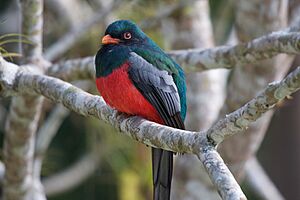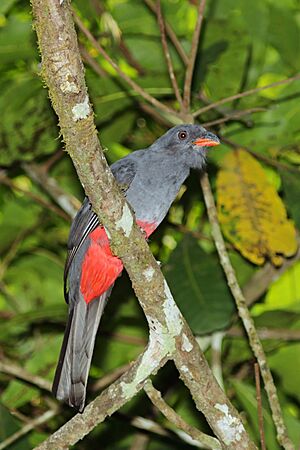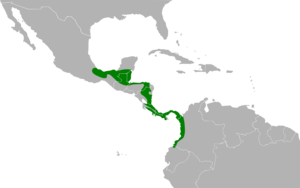Slaty-tailed trogon facts for kids
Quick facts for kids Slaty-tailed trogon |
|
|---|---|
 |
|
| Male, Belize | |
 |
|
| Female T. m. hoffmanni, Panama | |
| Conservation status | |
| Scientific classification | |
| Genus: |
Trogon
|
| Species: |
massena
|
 |
|
The slaty-tailed trogon (Trogon massena) is a beautiful bird known for its bright colors. It belongs to the Trogonidae family, which also includes the famous quetzals. You can find this bird in Mexico, all across Central America, and in parts of Colombia and Ecuador.
Contents
Meet the Slaty-tailed Trogon Family
Scientists group animals into families, and the slaty-tailed trogon is part of the Trogonidae family. Within this family, there are different types, or subspecies, of the slaty-tailed trogon. As of 2021, three main types are known: T. m. massena, T. m. hoffmanni, and T. m. australis. Sometimes, T. m. australis has been thought to be a different species or a type of black-tailed trogon.
What Does a Slaty-tailed Trogon Look Like?
Trogons are known for their soft, colorful feathers. Male and female trogons often look quite different from each other. The slaty-tailed trogon is about 30 to 35.5 cm (12 to 14 in) long. That's about the length of a ruler! It weighs around 140 to 155 g (4.9 to 5.5 oz), which is about as much as a small apple.
The male bird has a bright orange-red beak. His face, chin, and upper throat are a dull black, with a red or orange ring around his eye. His back and upper body are a shiny metallic green, which can look golden on his back and bluish-green on his head and rump. His chest is also metallic green, while his belly and bottom are a deep red. When his wings are folded, they look gray because of fine black and white lines. The top of his four middle tail feathers are metallic green or bronze with black tips. The feathers underneath his tail are slate gray with black tips.
The female slaty-tailed trogon looks a bit different. Most of her green feathers are replaced with gray. Her upper chest is a lighter gray than her back. The top of her tail is black, and the upper part of her beak is a dusky gray.
The male T. m. hoffmanni looks very similar to the main type, but his tail is more golden. The T. m. australis type is smaller. Its male has a bluish-green tail and more metallic green on his face and throat. The female T. m. australis has darker gray feathers than the other types.
Where Do Slaty-tailed Trogons Live?
These colorful birds live in different parts of Central and South America. The T. m. massena type lives on the Caribbean side from southern Mexico, through Belize, Honduras, and Guatemala, all the way to Nicaragua. The T. m. hoffmanni type is found on both the Caribbean and Pacific sides of Costa Rica and Panama. You can also find it in the very northwest part of Colombia. The T. m. australis type lives in western Colombia and the far northwest of Ecuador.
Slaty-tailed trogons mostly live in tropical evergreen forests. They like the middle and top parts of the trees. You might also spot them in older secondary forests (forests that have grown back after being cut down), in forests along rivers, in coffee farms, and even in mangrove swamps. They usually live in lowlands, but can sometimes be found higher up in places like Costa Rica, Panama, and Colombia.
Behavior of the Slaty-tailed Trogon
Feeding Habits
The slaty-tailed trogon enjoys eating both fruits and insects. It finds its food by flying out from a perch to catch insects in the air, or by hovering to pick them off leaves. Sometimes, these clever birds even follow white-faced capuchin monkeys. As the monkeys move through the trees, they disturb insects, making them easier for the trogons to catch!
Reproduction and Life Cycle
The breeding season for slaty-tailed trogons changes depending on where they live, but it generally happens between February and July. During this time, the male and female birds show off to each other. They raise their tails and fluff up the feathers on their upper tails.
They build their nests high up, sometimes as high as 15 m (49 ft) off the ground. They make their nests by digging a hole in an active termite nest or in a decaying tree trunk. Both the male and female work together to dig out the nesting chamber. A typical nest will have two or three eggs, which are usually white or bluish-white. Both parents take turns sitting on the eggs to keep them warm until they hatch.
What Does a Trogon Sound Like?
The song of the slaty-tailed trogon is a steady, slow series of "cow" or "cue" notes. Some people describe it as a deep, full-throated "wuk, wuk, wuk..." Besides their song, they also make calls. These include a quiet clucking sound like "huh-huh-huh-huh" and a "chuckling chatter."
How Are Slaty-tailed Trogons Doing?
The IUCN (International Union for Conservation of Nature) has looked at the slaty-tailed trogon and decided it is a species of "Least Concern." This means that it is not currently in danger of disappearing. It lives in a very large area, and even though scientists haven't counted every single bird, they believe the number of trogons is staying steady.
There are no immediate big dangers to this bird right now. However, the main threats are losing their forest homes because of trees being cut down (logging) and land being used for farms. Protecting their forest homes is important for these beautiful birds to continue to thrive.


